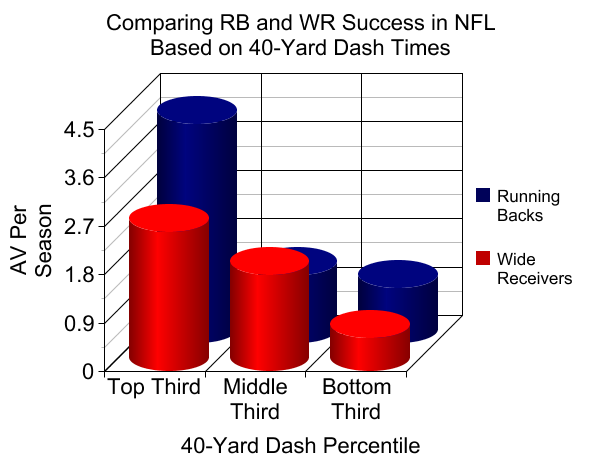This article is part of our According to the Data series.
Wide Receiver Speed Is Important, But Size Matters More
As I mentioned in my analysis of running back 40-yard dash times, the 2008 NFL Combine was littered with unreal speed at the running back position. Chris Johnson (4.24) led the way, but Darren McFadden (4.33), Jamaal Charles (4.38), Rashard Mendenhall (4.41), Ray Rice (4.42), Felix Jones (4.44), Matt Forte (4.44), Steve Slaton (4.45) and Jonathan Stewart (4.46) all burned up the track as well. Their subsequent success in the NFL isn't atypical; the majority of the league's top running backs can fly. Very few backs over the past decade have been able to overcome running 4.50+ times.
In the same 2008 Combine, the wide receiver class was just as fast; 20 receivers ran sub-4.5 times. Unlike the running backs, though, the receivers haven't fared too well in the big leagues. DeSean Jackson (4.35) has thus far been the best of the bunch, followed by Eddie Royal (4.39) and Pierre Garcon (4.42). Other names who tore it up in Indianapolis that year include Dexter Jackson (4.33), Arman Shields (4.37), Will Franklin (4.37), Devin Thomas (4.40), Brandon Breazell (4.41), Keenan Burton (4.44) and James Hardy (4.45), among others.
More speed is never a bad thing, but it "matters" more at certain positions. Cornerbacks, for example, need to have the recovery speed to catch up to receivers, so it's rare to see any successful cornerback run above a 4.50. We saw the same phenomenon with running backs, which was a bit unexpected.
Wide Receiver Speed Is Important, But Size Matters More
As I mentioned in my analysis of running back 40-yard dash times, the 2008 NFL Combine was littered with unreal speed at the running back position. Chris Johnson (4.24) led the way, but Darren McFadden (4.33), Jamaal Charles (4.38), Rashard Mendenhall (4.41), Ray Rice (4.42), Felix Jones (4.44), Matt Forte (4.44), Steve Slaton (4.45) and Jonathan Stewart (4.46) all burned up the track as well. Their subsequent success in the NFL isn't atypical; the majority of the league's top running backs can fly. Very few backs over the past decade have been able to overcome running 4.50+ times.
In the same 2008 Combine, the wide receiver class was just as fast; 20 receivers ran sub-4.5 times. Unlike the running backs, though, the receivers haven't fared too well in the big leagues. DeSean Jackson (4.35) has thus far been the best of the bunch, followed by Eddie Royal (4.39) and Pierre Garcon (4.42). Other names who tore it up in Indianapolis that year include Dexter Jackson (4.33), Arman Shields (4.37), Will Franklin (4.37), Devin Thomas (4.40), Brandon Breazell (4.41), Keenan Burton (4.44) and James Hardy (4.45), among others.
More speed is never a bad thing, but it "matters" more at certain positions. Cornerbacks, for example, need to have the recovery speed to catch up to receivers, so it's rare to see any successful cornerback run above a 4.50. We saw the same phenomenon with running backs, which was a bit unexpected. When we analyze wide receivers, the fastest ones have understandably had more success than others, but perhaps not to the degree you'd expect.
Below, I've sorted both running backs and wide receivers based on their approximate value per season and their 40-yard dash times at the Combine. I used every player from 2005 to 2009 (345 total) to allow time for each to develop in the NFL.

Speed obviously wins out for both groups, but the drop in NFL production from the running backs ranked in the top third to those ranked in the middle third (34th to 67th percentile) is extraordinary. On average, running backs who ranked in the top third of all 40-yard dash times have been over three times as valuable in terms of approximate value as those with moderate speed. On the flip side, the fastest wide receivers have barely outperformed players with moderate speed (between 4.45 and 4.54).
Because there's such a steep drop between the fastest running backs and those with a modest amount of speed, there's not much of a difference between the middle tier of backs and those ranked in the bottom third. That's pretty straightforward; if the chances of NFL success are already minimal for backs who clock between, say, 4.55 and 4.60, they aren't going to be too much worse for the slowest runners.
Since wide receivers with moderate speed can and have produced big-time numbers in the NFL, the drop between them and the slowest players at their position is steep - much more so than for running backs. In effect, the "cutoff" point of NFL success for wide receivers is simply lower than it is for running backs.
One of the reasons we see receivers with moderate speed have success in the NFL is that size probably matters more for them than for running backs. As the NFL has become more and more pass-heavy, backs like Chris Johnson and Jamaal Charles have been able to thrive despite small frames.
Meanwhile, take a look at the top 10 wide receivers in fantasy football this year (standard scoring): Calvin Johnson, Brandon Marshall, Dez Bryant, A.J. Green, Demaryius Thomas, Vincent Jackson, Andre Johnson, Eric Decker, Julio Jones and Roddy White. Every single one of those players stands at least 6-1, tall and weighs a minimum of 201 pounds. The average (the average!) is 6-3 and 220 pounds. Some of them ran outstanding 40-yard dashes, but others (Marshall, Bryant, Jackson, Decker, White) didn't light it up.
Thus, it isn't that being fast doesn't help receivers, but rather that the speed "cutoff" isn't as stringent as it is for running backs. Receivers also need two things to maximize their chances of success in the NFL. The first is size (especially height). The second is at least a moderate amount of speed (ideally under 4.55). A bunch of big receivers with moderate speed have succeeded of late - Marshall (4.52), Kenny Britt (4.51), Jordy Nelson (4.51), Dwayne Bowe (4.51), Hakeem Nicks (4.50) - but they're all very large. Meanwhile, only one receiver drafted between 2005 and 2009 has recorded a respectable AV per season (above 5.0) after running worse than a 4.52 at the Combine.
That player is Davone Bess, and he's hardly dominating fantasy football.
Jonathan Bales is the author of Fantasy Football for Smart People: How to Dominate Your Draft. He also runs the "Running the Numbers" blog at DallasCowboys.com and writes for the New York Times.










